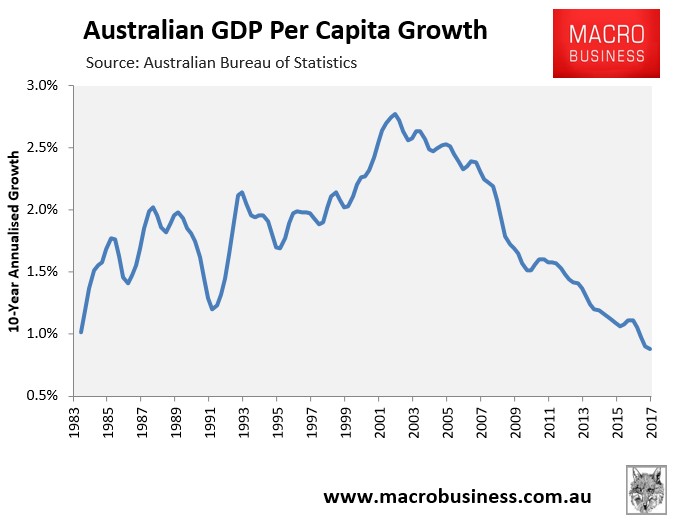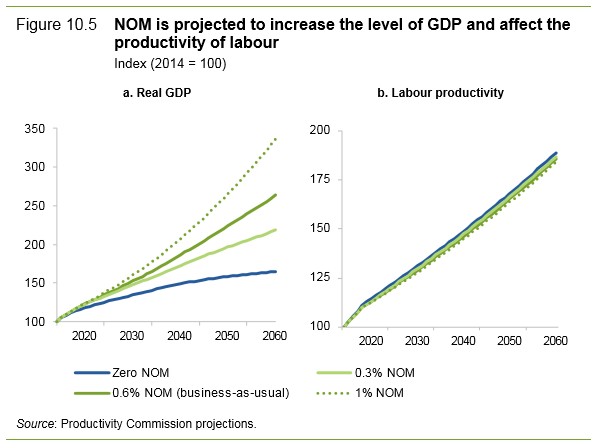Back in April, ABC’s The Drum aired a shockingly biased segment on the population (immigration) debate, which featured three avid mass immigration spruikers (including Fairfax’s Peter Martin) all pushing the Big Australia agenda.
Last night, The Drum aired another biased segment defending itself against The ABC’s alleged bias on the immigration issue, which again featured several commentators all arguing that mass immigration makes Australians unambiguously richer, while blaming concerns about infrastructure and housing in our major cities on poor planning rather than the 80,000 to 100,00 people that have been stuffed into Sydney and Melbourne each year over the past decade (and projected to do so for decades to come).
The best spin came from Alan Kirkland from Choice who argued the following:
“Maybe one of the reasons why The ABC and other media outlets have not covered this today is because it’s not a really well-founded argument. If you look at migration, predominantly people that arrive here are better educated than the rest of us, kids do better at school, and generally of workforce age, so they have this impact of giving us more people in the workforce, which delays the impact of an ageing population.
So, we’re getting a lot out of migration at the moment. It’s geared predominantly towards delivering what employers need – and that’s what fuels the economy – and that’s been one of the most consistent forces driving the economic growth in Australia decade upon decade. So, I don’t think it’s a really strong argument. Maybe that’s why it hasn’t been a story in the ABC angle”…
The missing piece has been the population has grown and that has fueled economic growth. But we’ve really dropped the ball on infrastructure. And on housing, in particular. So, people are really feeling real pressure. That’s why we’ve got an issue with housing affordability – that’s one of the key factors. We haven’t really dealt with infrastructure needs… So there is, in fact value in calling-out this debate. But I think we are actually focusing on the wrong solution. Cutting immigration won’t do it. We just need to plan better for the impacts of immigration on demand for services”.
All of these failed arguments have been debunked many times on this site.
The claim that immigrants are better educated and more skilled than the general population has been thoroughly debunked here and here.
The claim that immigration can, in any way, solve the problems of an ageing population have been destroyed here and here.
The notion that Australia should just build more infrastructure to support mass immigration has been debunked here.
The claim that mass immigration has “been one of the most consistent forces driving the economic growth in Australia decade upon decade” is true in an aggregate sense (more inputs in people equals more outputs in GDP). However, Australia’s GDP per capita growth has fallen precipitously as the migrant intake was ramped-up in the early-2000s (despite epic mining and housing booms):

The key threshold issue that needs to be assessed when discussing immigration is whether the current settings are making incumbent residents better-off? Don’t just take my word for it – the Productivity Commission (PC) explicitly noted the same in its recent Migration Intake into Australia report:
The Australian Government should… specify that the primary objective of immigration and the Government’s population policy is to maximise the economic, social and environmental wellbeing of the Australian community (existing Australian citizens and permanent residents) and their future offspring.
Unfortunately, the evidence does not support the notion that current mass immigration settings are making incumbent residents better-off. The evidence appears to be to the contrary.
In 2006, the PC completed a major study on the Economic Impacts of Migration and Population Growth, which modeled the impact of a 50% increase in the level of skilled migration over the 20 years to 2024-25 and found that “the incomes of existing resident workers grow more slowly than would otherwise be the case”.
The PC’s latest report, while it didn’t model distributional impacts from immigration, did find that real wages under existing mass immigration settings would be lower than would exist under zero net overseas migration (NOM):
Compared to the business-as-usual case, labour productivity is projected to be higher under the hypothetical zero NOM case — by around 2 per cent by 2060 (figure 10.5, panel b). The higher labour productivity is reflected in higher real wage receipts by the workforce in the zero NOM case.
More broadly, The Drum gave minimal attention to the huge negative externalities associated with mass immigration, which are not captured in the broad economic statistics nor economic modelling, but unambiguously hurt incumbent residents’ living standards. These include:
- Creating infrastructure bottlenecks, meaning incumbent residents spend more time stuck in traffic, waiting for a hospital spot, packed like sardines on a train, or jammed into an overcrowded classroom;
- Raising the cost (and reducing the quality) of housing, as young Australians are forced to pay more for lower quality housing (e.g. a highrise shoe box or a postage stamp-sized lot on the fringe);
- Diluting Australia’s fixed endowment of mineral resources across more people, meaning Australia must sell-off its finite resources faster to maintain a constant standard of living (other things equal);
- Blowing-out Australia’s trade and current account deficits as the immigrants flooding Melbourne and Sydney do not materially raise Australia’s exports (since most of these come from commodities and agriculture) while significantly increasing imports (as they purchase imported TVs, cars and the like).
- Environmental degradation, as Australia’s rapidly growing population puts increasing strains on Australia’s natural environment.
In short, the ABC panelists need to learn some basic economics as well as recognise that it is the living standards of the incumbent Australian population that is the threshold issue in the immigration debate. Living standards in the major cities are unambiguously being eroded by mass immigration via negative externalities that are not captured in the national economic accounts or modelling, such as increasing congestion, falling housing affordability, environmental degradation, etc. It is pointless fingering the failure to plan for these outcomes when it’s now been been obvious for a decade that governments have neither will, resources nor brains to do so.
Finally, pursuing high immigration is a growth fig leaf for governments and associated rent-seekers to pretend they’re doing the job rather than pursuing the more difficult but ultimately much wider benefits of productivity-directed reform. The ABC panelists have unknowingly played straight into the growth lobby’s hands.


